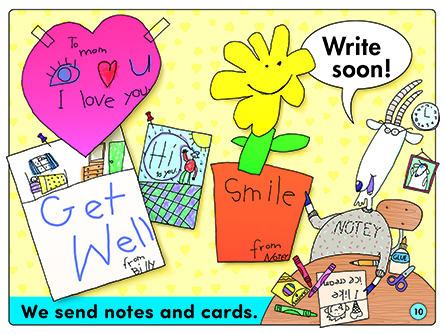Additional Activities
These activities offer options for continuing the learning in this unit. Whether your curriculum is skill-based or more open-ended, select the activities that are most appropriate for the children in your classroom. The Writing Spot is primarily a writing program, but writing can be integrated throughout your curriculum—in art, drama, reading, math, and science.
-
Supply note-writing materials.
Incorporate note writing in your classroom all year. Provide notepaper for birthdays, thank-yous, congratulations, condolences, and so on. Have volunteers write these notes on behalf of your class. (Implement any of the appropriate note forms: "Memo 1," "Memo 2," "Smile Note," "I like . . . ," "Star Note," and "Thank-You Note.")
-
Prepare notes and cards as a happy surprise.
Begin by placing an unexpected, happy note in each child’s cubby. Afterward, talk about how receiving these notes made the children feel. Have the students create a happy-day note for someone they live with, take the note home, and hide it as a surprise. Talk about possible hiding places. Later, discuss the children’s experiences with this activity. You may use "Smile Note" for this activity.
-
Do a shared writing thank-you note.
Do a shared writing, thanking a person or group (school nurse, cafeteria workers, etc.) for their work. Use a large piece of paper and involve the children as you compose the note. Finally, invite all of the children to sign it.
-
Share cards that say, “I like you!”
Write this sentence on the board: I like you because___________. Have the children read it aloud, and ask volunteers to suggest ways for finishing the sentence. Write each suggestion and ask the class to read it aloud with you. Then group the children into pairs and have partners create “I Like You Because” cards for someone. Use "I like . . ." for this activity.
-
Make cards to say, “Good for you!”
Talk about the importance of saying, “Good for you!” when someone has done something well. Brainstorm with the class for occasions when this is appropriate. Then group the children into pairs and have the partners create “Good for You” cards for each other. Use "Star Note" if you wish.
-
Use computer card-making programs.
If card-making computer programs are available, let children create original card designs using their names, initials, the school’s name, cheery words, and so on.
-
Send notes and cards that say, “I care.”
Have a class discussion about caring for others (showing love)—helping, remembering special days, saying “I’m sorry” or “Thank you,” and so on. With the children’s input, list special times for telling someone, “I care about you.” Consider group school projects that would say you care—picking up litter, painting a mural, and so on. Write a class note to the principal offering your help.
-
Write notes and cards to new friends.
For this ongoing activity, ask the director of a local nursing home to choose one resident each month to whom the children will send cards. Ask for a photograph and some background information about the person. Be certain that the children use the resident’s name in their messages. Talk about the mailing process as you address a large envelope for sending the students’ notes. If you wish, plan a field trip to the nursing home so the children can meet their new friends.
Option: Write friendly notes to a kindergarten class at another school, or to a class of older students in your own school. Pair each child in your class with a writing buddy in the other class. Every month, have them exchange notes or cards. At the end of the school year, get together for a party or picnic.
-
Discuss notes that share an important message or help us remember.
Talk about different kinds of notes—telephone messages, grocery lists, notes about special dates. Ask these questions: Are there notes on the class calendar? What do they say? Why are they important? What happens if you don’t leave a note when someone calls? Discuss the importance of taking school notes home to parents or caregivers. Then give the children a note to take home. In the note, explain that the class is learning to be responsible by delivering important notes. Ask a parent to sign the note and have the child return it to you.
-
Create note cards to accompany gifts.
When the children have made gifts to take home, have them include a note card. Provide 4" ✕ 6" cards. On one side, they should print “To:” and the receiver’s name, and on the other side, “From:” and their own name. They may also decorate the cards. Finally, have them tape the card to the gift.
-
Go online for a virtual tour of a greeting card company.
Explain that writers write the messages, and artists draw the pictures for greeting cards. Visit card sites you have previewed on the Internet. Many offer animated e-cards for kids. Contact the public relations departments of the big card companies about virtual tours, or search for “virtual tours” online.
